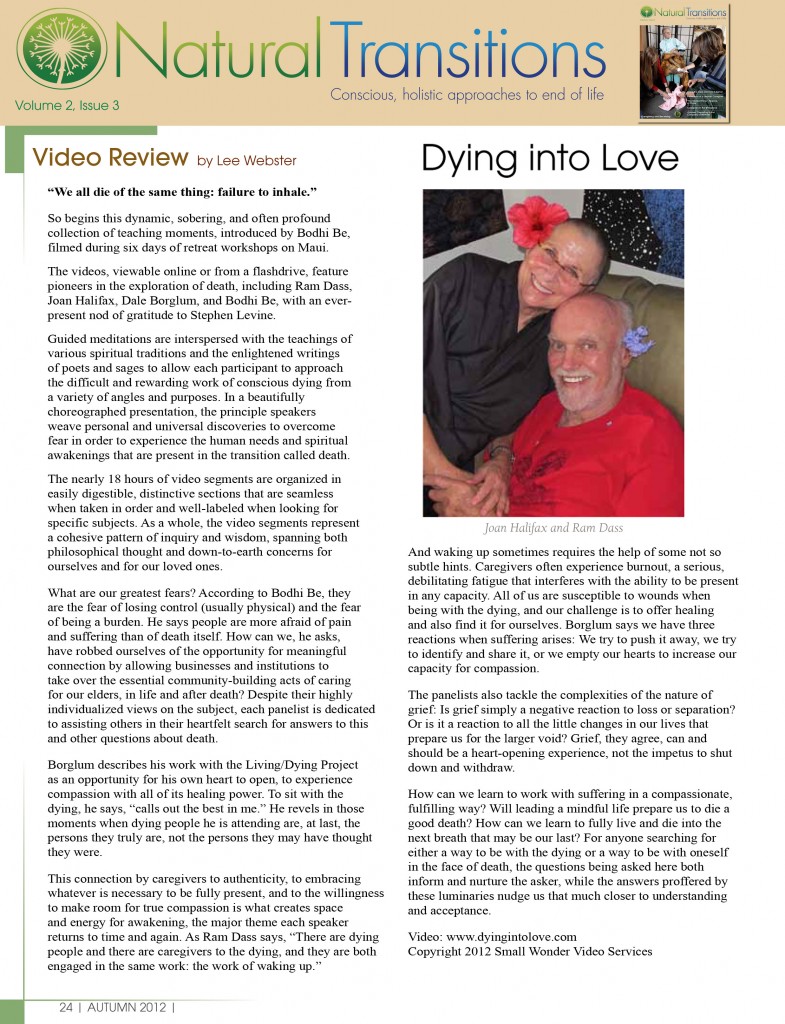Click image to enlarge or scroll down for text.
Natural Transitions Magazine:
Conscious, holistic approaches to end of life
Video Review of Dying into Love by Lee Webster
“We all die of the same thing: failure to inhale.” – Ram Dass
So begins this dynamic, sobering, and often profound
collection of teaching moments, introduced by Bodhi Be,
filmed during six days of retreat workshops on Maui.
The videos, viewable online or from a flashdrive, feature
pioneers in the exploration of death, including Ram Dass,
Joan Halifax, Dale Borglum, and Bodhi Be, with an everpresent
nod of gratitude to Stephen Levine.
Guided meditations are interspersed with the teachings of
various spiritual traditions and the enlightened writings
of poets and sages to allow each participant to approach
the difficult and rewarding work of conscious dying from
a variety of angles and purposes. In a beautifully
choreographed presentation, the principle speakers
weave personal and universal discoveries to overcome
fear in order to experience the human needs and spiritual
awakenings that are present in the transition called death.
The nearly 18 hours of video segments are organized in
easily digestible, distinctive sections that are seamless
when taken in order and well-labeled when looking for
specific subjects. As a whole, the video segments represent
a cohesive pattern of inquiry and wisdom, spanning both
philosophical thought and down-to-earth concerns for
ourselves and for our loved ones.
What are our greatest fears? According to Bodhi Be, they
are the fear of losing control (usually physical) and the fear
of being a burden. He says people are more afraid of pain
and suffering than of death itself. How can we, he asks,
have robbed ourselves of the opportunity for meaningful
connection by allowing businesses and institutions to
take over the essential community-building acts of caring
for our elders, in life and after death? Despite their highly
individualized views on the subject, each panelist is dedicated
to assisting others in their heartfelt search for answers to this
and other questions about death.
Borglum describes his work with the Living/Dying Project
as an opportunity for his own heart to open, to experience
compassion with all of its healing power. To sit with the
dying, he says, “calls out the best in me.” He revels in those
moments when dying people he is attending are, at last, the
persons they truly are, not the persons they may have thought
they were.
This connection by caregivers to authenticity, to embracing
whatever is necessary to be fully present, and to the willingness
to make room for true compassion is what creates space
and energy for awakening, the major theme each speaker
returns to time and again. As Ram Dass says, “There are dying
people and there are caregivers to the dying, and they are both
engaged in the same work: the work of waking up.”
And waking up sometimes requires the help of some not so
subtle hints. Caregivers often experience burnout, a serious,
debilitating fatigue that interferes with the ability to be present
in any capacity. All of us are susceptible to wounds when
being with the dying, and our challenge is to offer healing
and also find it for ourselves. Borglum says we have three
reactions when suffering arises: We try to push it away, we try
to identify and share it, or we empty our hearts to increase our
capacity for compassion.
The panelists also tackle the complexities of the nature of
grief: Is grief simply a negative reaction to loss or separation?
Or is it a reaction to all the little changes in our lives that
prepare us for the larger void? Grief, they agree, can and
should be a heart-opening experience, not the impetus to shut
down and withdraw.
How can we learn to work with suffering in a compassionate,
fulfilling way? Will leading a mindful life prepare us to die a
good death? How can we learn to fully live and die into the
next breath that may be our last? For anyone searching for
either a way to be with the dying or a way to be with oneself
in the face of death, the questions being asked here both
inform and nurture the asker, while the answers proffered by
these luminaries nudge us that much closer to understanding
and acceptance.
Video: www.dyingintolove.com
Copyright 2012 Small Wonder Video Services
Natural Transitions
Volume 2, Issue 3
Page 24 – AUTUMN 2012
http://www.naturaltransitions.org/

